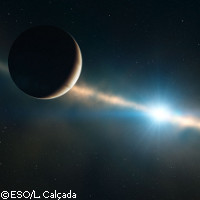Newfound planet emerges from stardust
Giant gas planets can form much faster than previously believed, according to new research by an international team of astronomers published in the journal Science. The discovery is based on observations of a planet orbiting a star called Beta Pictoris that lies some 60 light years from Earth in the direction of the constellation Pictor (the painter). The observations were made using instruments mounted on the Very Large Telescope (VLT), which is located in Chile and run by the European Southern Observatory (ESO). Aged just 12 million years, Beta Pictoris is a relatively young star (our Sun, at 4.5 billion years, is considered middle-aged). Beta Pictoris is surrounded by a dusty disc of debris, which is made of dust particles formed during collisions between solid objects such as comets. This dusty disc has been the subject of intensive study for around 25 years. These investigations revealed asymmetries within the disc that were theoretically linked to the presence of one or more massive planets within the disc. 'Those were indirect but tell-tale signs that strongly suggested the presence of a massive planet, and our new observations now definitively prove this,' explained Anne-Marie Lagrange of the Laboratory of Astrophysics at the Observatory of Grenoble in France. The first major hint that Beta Pictoris' debris disc may be harbouring a large planet came in November 2003, when images revealed a faint light source inside the disc. However, at that time it was not possible to exclude the possibility that the light source was another star in the background of the picture. In subsequent images taken in 2008 and early 2009, the light source had disappeared. However, in images dating from late 2009, the light source is back, this time on the other side of the disc. According to the researchers, this confirms that the object is indeed a planet. During the period when the planet was invisible, it was either passing behind the star or in front of it (in which case it would have been masked by stellar glare). 'Because the star is so young, our results prove that giant planets can form in discs in time-spans as short as a few million years,' stated Dr Lagrange. Analyses of the images reveal that the new planet, called Beta Pictoris b, is about 9 times bigger than Jupiter and orbits its star at a distance of between 8 and 15 Astronomical Units (1 Astronomical Unit being the distance between the Earth and our Sun, or around 150 million kilometres). This orbit makes Beta Pictoris b much closer to its parent star than any of the other exoplanets imaged so far. 'The short period of the planet will allow us to record the full orbit within maybe 15 to 20 years, and further studies of Beta Pictoris b will provide invaluable insights into the physics and chemistry of a young giant planet's atmosphere,' commented student researcher Mickael Bonnefoy of the Observatory of Grenoble. As well as confirming the speed at which planets can form, the discovery adds to our understanding of how planets interact with gas discs. 'The recent direct images of exoplanets - many made by the VLT - illustrate the diversity of planetary systems,' concluded Dr Lagrange. 'Among those, Beta Pictoris b is the most promising case of a planet that could have formed in the same way as the giant planets in our Solar System.'
Countries
Germany, France, United States



